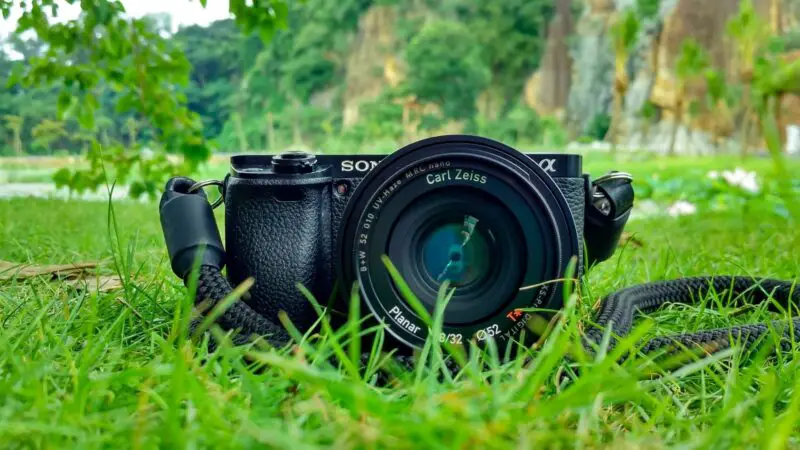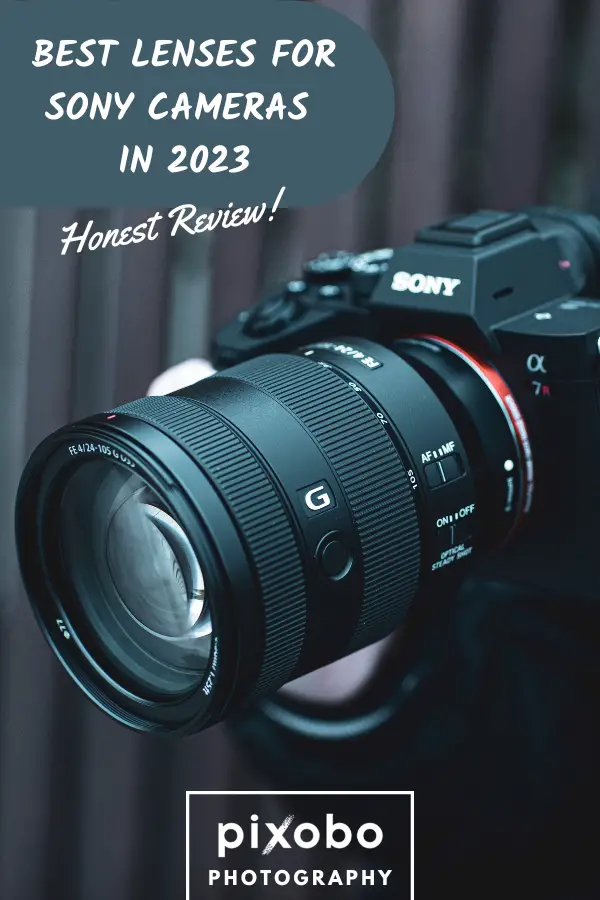Sony changed the full-frame mirrorless camera scene in 2013 when it released the a7 and a7R. Therefore, it did not come as a surprise when the company decided to stop making DSLR (SLT) cameras and A-mount lenses. It also appears that Sony is now focusing on full-frame rather than APS-C format cameras and their dedicated lenses.
A Sony FE (full-frame) lens can also be used for Sony APS-C mirrorless cameras. But since APS-C sensors are smaller, you will get a narrower field of view (FOV) angle. Hence, a 35mm focal length will become 50 mm on a crop APS-C sensor. Here are the best full-frame lenses for Sony mirrorless cameras in 2024.
Table of Content
Landscape and Travel Photography

1. Sony FE 16-35mm F2.8 GM
- Designed to achieve 50 Line pairs/mm resolving power
- Two XA (extreme aspherical) elements w/ high surface precision. Minimum focus distance - 0.28 m (0.92 ft). Maximum Magnification ratio (x)- 0.19
- Constant F2.8 max aperture maintains exposure and Depth of field. Hood Type : Petal shape, bayonet type; APERTURE BLADES: 11
Announced in May 2017, the Sony FE 16-35mm F2.8 GM is a premium wide-angle zoom lens designed for the company’s full-frame mirrorless cameras, such as the A7R III and Sony a7S III. It is also Sony’s first professional zoom lens that can be used for their APS-C E-mount cameras, with a 24-52.5mm full-frame angle of view equivalent.
Ideal for landscape photography, the Sony FE 16-35mm f/2.8 G Master consists of 16 elements in 13 groups. This includes two XA (extreme aspherical), three aspherical elements, and two ED (extra-low dispersion) elements. This proud member of the Grand Master (GM) lens series is also built with a Nano AR (anti-reflective) coating.
This Sony FE 16-35mm F2.8 GM has a minimum focusing distance of 28 cm (11.02 inches) at a maximum magnification of 0.19x, 11 rounded diaphragm blades, and an internal focusing mechanism. This professional-grade lens uses two DDSSMs (Direct Drive Super Sonic Wave Motors) to produce precise, quiet, and smooth focusing.
The Sony zoom lens does not feature a built-in Optical SteadyShot. Fortunately, this is not a problem since newer Sony mirrorless cameras have IBIS (In-Body Image Stabilization). This weather-sealed zoom lens is medium-sized and weighs only 680 grams (1.49 lbs). The price is quite high, but its features make it worth your money.
2. Sony FE 12-24mm f/2.8 GM
- World’s widest full-frame constant F2.8 at 12-24mm
- F2.8 max aperture provides extraordinary exposure and depth of field
- Spectacular resolution: 3x Extreme Aspheric elements, 1x Aspheric
Released in August 2020, the Sony FE 12-24mm f/2.8 GM is a state-of-the-art full-frame ultra-ultrawide lens ideal for landscape photography. As the 11th member of the Sony GM lenses, it is the world’s first f/2.8 12-24mm lens. This lens is currently the world’s widest F2.8 zoom lens, designed for Sony full-frame E-mount mirrorless cameras.
Optically, the Sony FE 12-24mm f/2.8 GM comprises 17 elements in 14 groups. This includes three XA (extreme aspheric) elements, three ED elements, two Super ED elements, and one standard aspherical element. It is also built using fluorine coating and the upgraded Nano AR Coating II for better reduction of flare and ghosting.
Additionally, it is aimed at demanding professional photographers. This 12-24mm f/2.8 lens uses 4 XD linear motors, a 9-rounded blade diaphragm, a Linear Response manual focus control, an AF hold button, smooth focus and zoom rings, and an IF mechanism. It also allows a minimum focus distance of 0.28m (0.92 m) at a maximum magnification of 0.14x.
This 847-gram (1.87 lbs) lens has no image stabilization and relies on the built-in IBIS in Sony mirrorless cameras. It also does not have an aperture ring, does not support front filters, and is quite bulky. Not to mention, this lens is very expensive. But weighing all the pros and cons, this FE f/2.8 GM lens is worth every penny.
3. Tamron 17-28mm F2.8 Di III RXD
- World's most lightweight large aperture wide-angle zoom in its class (smaller than original F4 lens)
- Superb image quality high mtf performance (utilizing the camera body compensation)
- The RXD stepping motor unit is exceptionally quiet
Announced in June 2019, the Tamron 17-28mm F2.8 Di III RXD (Model A046) is a wide-angle zoom lens that became an instant best-selling lens shortly after its launch. This is also aimed at enthusiasts and professionals in landscape photography. Its 17–28mm zoom range works well in Sony Alpha E-Mount full-frame and APS-C mirrorless cameras.
Theoretically, a wide aperture requires larger lens elements, which ends in a heavier and more expensive lens. But surprisingly, this Tamron 17-28mm F2.8 Di III is only 99 cm (3.9 inches) long and weighs only 420 grams (0.92 lb). It comprises 13 elements in 11 groups, including two LD lens glass elements and one XLD element.
In addition, the lens surface is built with BBAR (Broad-Band Anti-Reflection) Coating, which effectively reduces ghosting and flare. This super-small, lightweight lens has a minimum focus distance of 19 cm (7.5 in) at 0.19x maximum magnification. It also has a 67-mm filter thread, which is incredibly small for an ultra-wide-angle zoom lens.
As a weather-sealed lens, this Tamron 17-28mm F2.8 lens has a Fluorine coating that protects the front element and is easier to clean. The image quality is excellent and closely matches that of the more expensive Sony GM lenses. In general, this fast and superbly quiet Tamron lens is a great option to save money.
4. Sony E 10-18 Mm F4 OSS
- Angle of View (APS-C) - 109 ° – 76 °
- Minimum focal length of 10 mm (15 mm in 35 mm-camera equivalency)
- Minimum Focus Distance : 0.82 ft (0.25 m), Maximum Magnification ratio : 0.1x
Of all the lenses made by Sony, the Sony E 10-18 mm F4 OSS lens has the shortest focal length (10 mm) and the broadest field of view. With a size of 70 x 63.5 mm and a weight of only 225 grams, you can simply slip this lens into your pocket and take special photos while traveling.
It is the only ultra-wide zoom lens available from the manufacturer for its APS-C mirrorless system. The lens’s expanded field of view gives your pictures more depth and striking clarity, enabling you to take unique pictures.
When a regular zoom isn’t enough, and you need a wider field of view, this lens takes over with a wide-angle zoom range of 15-27mm in full-frame terms. As a result, with a constant f/4 aperture, it is a compelling option for interior and exterior architecture photography.
Moreover, a constant f/4 aperture rating and a 3-stop OSS (Optical SteadyShot) stabilizer are appealing features. Three aspherical elements, one Super ED (Extra-low Dispersion) element, and eight groups of 18 optical elements make up the optical path, which aims to improve sharpness and lessen color fringing.
Portrait and Outdoor Photography

1. Sony FE 70-200mm F2.8 GM OSS II
- The FE 70-200mm F2.8 GM OSS delivers superb Image quality throughout the zoom range at all focusing distances with two aspherical elements and one XA (extreme aspherical) element to ensure high resolution throughout the image area. Two ED (extra-low dispersion) glass elements, two Super ED glass elements and one ED aspherical element to minimize chromatic aberration while Sony’s Nano AR (anti-reflective) Coating II subdues flare and ghosting. For additional reach, high-performance 1.4x and 2x teleconverters are available (sold separately)..Angle of View (APS-C) : 23゚- 8゚6, Maximum Magnification ratio (x) : 0.3
- Four of Sony’s original XD (Extreme Dynamic) Linear Motors deliver high thrust efficiency that boosts AF speed by up to 4x compared to the previous model for fast, precise continuous autofocus and tracking for stills and movies. AF tracking while zooming is improved by approx. 30% which greatly increase chances of getting the shot even with subjects moving rapidly towards the lens.
- Designed with movie magic in mind and the latest lens technology to reduce focus breathing, focus shift when zooming and axis shift when zooming. The XD Linear Motors and a new aperture drive unit contribute to quiet operation and independent control rings for focus, zoom and iris, with a click on/off switch for the aperture ring, make this lens ideal for movie shooting. Sony’s Linear Response MF feature ensures responsive and repeatable direct manual focus control.
Announced in October 2021, the Sony FE 70-200mm F2.8 GM OSS II is an outstanding successor to the popular Sony FE 70-200mm F2.8 GM OSS. This GM lens is aimed at professional portrait photographers for full-frame Sony Alpha mirrorless cameras. It also works well with Sony APS-C cameras at 105-300mm equivalent focal length range.
This is dubbed as the world’s lightest 70-200mm F2.8 zoom lens. It weighs only 1045 grams (2.3 lbs), 435g lighter than its predecessor. It has an optical construction of 17 elements in 14 groups, including one XA element, two Super ED elements, two ED elements, and one aspherical element.
This Sony FE 70-200mm lens features 4 XD linear motors, 11 rounded diaphragm blades, a 77-mm filter thread, and built-in 5-axis Optical SteadyShot image stabilization. It also allows a minimum focusing distance of 0.40 m (15.75 inches) at 0.30x maximum magnification and is built using Nano AR Coating II to prevent flare and ghosting.
Although 70-200mm lenses are best suited for portraits, the wide f/2.8 constant aperture is great for indoor action sports such as basketball. With fast autofocus and producing excellent image quality overall, this teleconverter-compatible FE 70-200mm F2.8 GM OSS II is a must-have lens. But then, it comes with a very hefty price tag.
2. Tamron 35-150mm f/2-2.8 Di III VXD
- The world's first F2-2.8 fast aperture zoom lens
- Outstanding optical performance throughout the range
- Fast, quiet VXD linear motor for high-speed and high-precision autofocus
Announced in August 2021, the Tamron 35-150mm f/2-2.8 Di III VXD (Model A058) is a wide-angle to medium telephoto zoom lens built for enthusiasts and professional photographers. Interestingly, this versatile lens is ideal for landscape, outdoor, and portrait photography, especially in low-light situations with blurred backgrounds.
Described by Tamron as the world’s first zoom lens designed for Sony full-frame mirrorless cameras to have an f/2 maximum aperture, the 35-150mm f/2-2.8 Di III VXD has a complex optical of 21 elements in 15 groups. This includes four LD (Low Dispersion) elements and three astonishing GM (Glass Molded Aspherical) elements.
This 540-gram (1.19 lbs) lens also uses VXD (Voice-coil eXtreme-torque Drive) linear motor to achieve faster and more precise autofocus. Tamron used BBAR-G2 (second-generation Broad-Band Anti-Reflection) Coating to effectively reduce flare and ghosting. It has 9 circular diaphragm blades and accepts 82-mm front filters.
The Tamron 35-150mm f/2-2.8 Di III VXD allows a minimum focus distance of 0.18 m (7.09 inches) at a maximum magnification of 0.37x. But as expected, it has no image stabilization and does not come with a tripod collar. It is also not ideal for macro shots. Despite being bulky and expensive, this lens has superb overall performance.
3. Sony FE 85mm F1.4 GM
- E-Mount Lens/Full-Frame Format
- Minimum Focus Distance : AF 2.79 ft, MF 2.62 ft, Maximum Magnification ratio (x) - 0.13 x, Focal-Length : 85 mm.Angle of view (APS-C) 19°
- Aperture Range: f/1.4 to f/16 , Filter Diameter (mm) - 67 mm
For many experienced portrait photographers, the 85mm prime lens is the best glass since it does not distort facial features, thus producing an exceptionally flattering linear perspective. Released in February 2016, the Sony FE 85mm F1.4 GM has exciting portrait lens features. No wonder Sony described it as the ultimate portrait prime.
Designed to work well with Sony Alpha mirrorless cameras, the FE 85mm F1.4 GM consists of 11 elements in 8 groups. This includes an extremely precise XA (extreme aspherical) element and three ED glass elements. This premium short telephoto full-frame prime lens has a circular 11-blade diaphragm and can accept 77-mm front filters.
The Sony FE 85mm F1.4 GM offers a minimum focusing distance of 0.8m (2.62 ft) at a maximum magnification ratio of 0.12x. The lens is equipped with a linear SSM (Super Sonic wave Motor) system for fast and smooth auto-focusing, which can be a bit noisy when shooting video. Nevertheless, it works very quietly while focusing on photo shoots.
Unfortunately, you cannot switch from focus to fly by wire. This could be a major problem if you are a vlogger or a videographer. On the other hand, this Sony 85mm lens weighs 820 grams (1.80 lb), which is lightweight if you are conducting interviews and making a documentary. This lens is expensive, but the performance justifies the price.
4. Sony FE 135mm F1.8 GM
- INCREDIBLY SHARP: XA (extreme aspherical), Super ED (extra-low dispersion) and ED glass elements strategically deployed in an advanced optical design for superb resolution, clarity and contrast
- BEAUTIFULLY SMOOTH BACKGROUNDS: Circular 11-blade aperture for beautiful bokeh defocus effects
- CAPTURE ALL THE DETAIL: Sony Nano AR Coating to eliminate flare and ghosting
Its 135mm F1.8 focal length makes it a unique tool for portraiture, but it can also reach pretty near macro images and has a rapid enough focus to keep up with fast activity. When paired with the 135mm focal length, the Sony FE 135mm f/1.8 GM’s outstanding minimum focusing distance of 70 cm and a maximum magnification of 0.25x can capture tiny subjects with striking degrees of background blur.
The 135mm lens is ideal for close-up portraits and any other photography situation requiring flawless picture quality at this focal length. Its near-circular 11-blade diaphragm, the largest ever employed in an Alpha lens, produces an extremely appealing blur in the image’s out-of-focus regions.
If you’re using autofocus and don’t want your lens to refocus, this lens has two circular Focus Hold Buttons that lock the lens to the current focusing distance. The preview feature may likewise be given to these buttons on its custom settings.
Macro Photography

1. Sigma 105mm f/2.8 DG DN Macro Art
- SIGMA Art line class optical and AF performance
- Life-sized magnification (1:1) short tele macro for full-frame mirrorless
- Clicked and de-clicked aperture ring with Aperture Ring Lock Switch
Released in October 2020, the Sigma 105mm f/2.8 DG DN Macro Art is a true macro lens designed for Sony E-mount and Leica L-mount full-frame mirrorless cameras. This mid-telephoto macro prime lens has a 1.0x maximum magnification, making it ideal for extreme close-up photography. More importantly, it comes at a very affordable price.
The Sigma 105mm f/2.8 DG DN Macro Art is the first Art macro lens for mirrorless cameras. It comprises 17 elements in 12 groups, which include one Special Low Dispersion (SLD) element and a Super Multi-layer coating. This lens has a 9-blade count diaphragm, an aperture ring with a lock switch, and an internal focusing (IF).
There is no optical image stabilizer, which can be compensated if you pair it with newer Sony mirrorless cameras with built-in IBIS (In Body Image Stabilization). And although the L-mount version can be mounted with Sigma teleconverters, the E-mount version does not have this ability. It also has a minimum aperture of only f/22.
To achieve the life-size maximum magnification of this lens, you should shoot at the shortest available focus distance, which is 29.5 cm (11.6 inches). This lens also sports a Hyper-Sonic Motor that provides fast and quiet AF performance and accepts 62mm front filters. Overall, this 715-gram Sigma 105mm f/2.8 is an excellent macro lens.
2. Sony FE 90mm f/2.8 Macro G OSS
- CLARITY FROM MACRO TO INFINITY: The floating system reduces the size of the lens while maintaining outstanding clarity throughout the image area, from infinity to the closest focusing distance.
- BEAUTIFULLY SMOOTH BACKGROUNDS: Smooth bokeh is supported by a 9-blade circular aperture mechanism with natural looking results
- ALWAYS RELIABLE: A dust and moisture resistant design provides the reliability needed for outdoor use in challenging conditions.
Announced in March 2015, the Sony FE 90mm f/2.8 Macro G OSS is a true macro lens, which means it can shoot up to life-sized 1x maximum magnification. This optically superb lens is known for being the first mid-telephoto macro lens for Sony E-mount full-frame mirrorless cameras to have built-in Optical SteadyShot (OSS) image stabilization.
This Sony FE 90mm f/2.8 Macro G OSS lens features 15 elements in 11 groups. This includes one ED (Extra-low Dispersion) element, one Super ED element, and one aspherical lens element. The life-sized maximum magnification can be achieved at a minimum focusing distance of 28 cm (11.02 inches), thus producing sharp images.
This Sony macro lens sports a fast and quiet Direct Drive SSM (DDSSM) mechanism, 9 curved-blade apertures, a focus hold button, an external sliding focus ring with a clutch mechanism that works flawlessly, and accepts 62-mm front filters. Sony does not claim any weather sealing in this lens but rather has a dust and moisture-resistant design.
As expected, this lens is incompatible with Sony 1.4x and 2.0x teleconverters. The angle of view at 90-mm focal length is 27°, which will be reduced to 17º when used on Sony APS-C cameras. The image quality is superb, with minimal chromatic aberration and distortion. With its low price, this 602-gram Sony macro lens is a sure steal.
3. Sony FE 50mm F2.8 Macro
- Full-frame 50mm macro lens with 1:1 magnification, F2.8 max. aperture for low-light and shallow depth of field, Get close with 6.25” (0.16m) minimum focusing distance
- ED glass effectively compensates for axial chromatic aberration, Robust and reliable dust and moisture resistant design, Focus-mode switch, focus-range limiter and focus-hold button
- Distance scale, Magnification scale and Distance index, Compact (2.78”) and lightweight (8.3 oz.) for high mobility, Great for scenery and portraits as well as macro shots
Announced in August 2016, the Sony FE 50mm F2.8 Macro is a true macro lens and an alternative to the more expensive Sony FE 90mm f/2.8 Macro G OSS. But the money you can save will also give you some disadvantages. Nevertheless, it does not necessarily mean that the 90mm macro is better than the 50mm macro in all aspects.
The difference between these two Sony macro lenses is that the Sony FE 50mm has a shorter focal length. This led to a bigger angle of view at 47° at 50 mm instead of 27° at 90 mm. Hence, it has a shorter minimum focus distance of 16 cm (16.3 inches) instead of 28 cm. Yet, both of them can have a 1x maximum magnification.
Optically, the Sony FE 50mm F2.8 Macro has 8 elements in 7 groups, including one ED (Extra-low Dispersion) glass element. It only has 7 rounded diaphragm blades rather than 9 and accepts smaller 55-mm front filters. Instead of a convenient focus clutch ring, you must use the AF/MF selection switch, which can be hard sometimes.
Like the FE 90mm, the FE 50mm will also rely on the camera’s built-in image stabilization. The good news is that it only weighs 236 grams (0.52 lb) or is almost 60% lighter than its much bigger cousin. Not to mention, the FE 50mm F2.8 Macro is also much cheaper. The overall performance and image quality are both great for a smaller lens.
Wildlife and Sports Photography

1. Sony FE 600mm F4 GM OSS
- World’s lightest1 600mm super-telephoto full frame wide-aperture F4 lens
- Large XA (extreme aspherical) element suppresses spherical aberration
- 2x Extreme Dynamic - XD Linear Motors for fast, precise, quiet AF
Announced in June 2019, the Sony FE 600mm F4 GM OSS is the company’s first 600-mm lens for its full-frame mirrorless cameras, such as the Alpha 9 II and 7R III. Aimed at professional photographers, this G Master telephoto prime fits the requirement for safety while taking photos of wildlife and avoiding being an obstruction in sports events.
The Sony FE 600mm F4 GM has 18 elements in 24 groups, including three fluorite elements, two ED (extra-low dispersion) glass elements, and an extreme aspherical lens (XA) element. This 3040-gram (6.7 lb) lens has two extreme dynamics (XD) linear motors to provide fast and accurate autofocus, along with four focus-hold buttons.
This Sony super-telephoto lens allows a minimum focus distance of a whopping 4.5m (14.7 ft) at a maximum magnification of 0.14x and accepts 40.5-mm front filters. It also has an 11-blade aperture, a Full-Time DMF switch, and an AF/MF switch. More importantly, this lens has built-in Optical SteadyShot image stabilization.
This FE 600mm F4 GM is constructed with Nano AR (anti-reflection) coating to reduce flare and ghosting. The front lens also has a fluorine coating, which repels water droplets and grease, making cleaning easy. As expected, this gigantic lens supports Sony teleconverters. With all of the benefits, this super-expensive lens is not for everyone.
2. Sony FE 200-600mm F5.6-6.3 G OSS
- Outstanding g lens resolution throughout the Zoom range
- 5x ED (extra-low dispersion) glass elements Reduces flare & ghosting
- Direct drive Supersonic Wave Motor for fast, quiet, precise focus
Sony announced the FE 200-600mm F5.6-6.3 G OSS in June 2019, alongside the FE 600mm F4 GM. Despite being a lot cheaper, this 200-600mm lens has many impressive features intended for wildlife and sports photography. No wonder this lens immediately caught the attention of many photo enthusiasts and semi-professional photographers.
Like the 600mm F4 GM, this 200-600mm F5.6-6.3 G has built-in Optical SteadyShot image stabilization with three modes, an 11-blade aperture, and a focus range limiter as Nano AR, and fluorine coatings. But then, it uses a Direct Drive SSM (DDSSM) system, which is a bit slower than the XD linear motors found in the 600mm F4 GM.
The Sony FE 200-600 F5.6-6.3 G OSS has 24 elements in 17 groups, including five ED (extra-low dispersion) elements and one aspherical lens. It also features an internal zoom mechanism, meaning the lens length does not change when zoomed. This allows handheld stability and reduces the risk of dirt and grit inside the lens.
This telephoto lens has a minimum focusing distance of 2.4 m (7.88 ft) at 0.2x maximum magnification. It also has a lens hood and is compatible with Sony 1.4x or 2.0x teleconverters. Measuring 318 mm (12.7 inches) and weighing 2,115 grams (4.6 pounds), this FE 200-600mm F5.6-6.3 G is portable enough and a superb performer.
3. Tamron 150-500mm F5-6.7 Di III VC VXD
- Versatile ultra Telephoto zoom for Sony E-mount full-frame-format mirrorless cameras with a 225-750mm equivalent focal length when used on an APS-C format camera body.
- VC image stabilization facilitates shooting handheld at the 500mm ultra-telephoto position, with three modes: standard, panning, and framing priority.
- XLD (eXtra Low Dispersion), LD (Low Dispersion), and GM (Glass-Molded Aspherical) elements greatly reduce color fringing, chromatic aberrations, and image distortion throughout the zoom range for improved clarity and color accuracy.
Released in June 2021, the Tamron 150-500mm F5-6.7 Di III VC VXD is the company’s first super-telephoto zoom designed for Sony full-frame mirrorless cameras. This third-party lens is cheaper than its Sony competitors but still has excellent bird and wildlife photography features. But then, there are some limitations that you should know.
With an optical construction of 25 elements in 16 groups, the Tamron 150-500mm F5-6.7 Di III has five Low Dispersion (LD) elements, two Hybrid Aspherical elements, and one Extra Low Dispersion (XLD) element. This lens also has BBAR-G2 (Broad-Band Anti-Reflection Generation 2) coating to suppress flare and ghosting.
Armed with an iris diaphragm with seven rounded aperture blades, this Tamron zoom lens allows a minimum focus distance of 60 cm (23.6 in) at a maximum magnification of 0.32x. It also has a Flex Zoom Lock mechanism, a VC (Vibration Compensation) image stabilization system with three different modes, and accepts 82-mm front filters.
As the name suggests, this Tamron 150-500mm F5-6.7 Di also sports a VXD (Voice-coil eXtreme-torque Drive) linear motor, which offers quick and quiet autofocusing. It is also lightweight at 1724 grams (3.80 lb) but will not work with teleconverters. This Tamron lens is not as sharp as the Sony FE 200-600mm, but still an excellent glass for its price.
4. Sony FE 400mm F2.8 GM OSS
- World's lightest 400mm F2.8 super-telephoto Lens
- (extreme dynamic) Linear motors for fast, precise, quiet AF
- G Master quality with superior focusing speed up to 20Fps
In 2018, the company released its first premium lens for its mirrorless system. Buyers of this lens will mostly be professional and amateur (or simply affluent), who want distinctively excellent image quality. These photographers will typically focus on sports, wildlife, and photojournalism when using this lens because of its focal length and maximum aperture combination.
The f/2.8 aperture perfectly complements the small angle of view. This lens’s 400mm focal length and relatively low weight make it a suitable option for shooting birds or flying dogs. f/2.8 is frequently the minimum needed to prevent unsightly-high ISO settings while trying to stop subject and camera motion in low-light situations, indoors and outdoors.
The new XD Linear Motor, powered by innovative control algorithms, accelerates the autofocus up to five times faster than ring-type SSM systems. Sony further asserts that the focusing performance is maintained whether the 1.4x or 2x teleconverters are attached. The lens also has focus range limiters, four focus lock buttons, optical stabilization, and a twistable function ring that may be set to return to previously focused distances.
Everyday Shooting

1. Sony FE 24-105mm F4 G OSS
- G-lens design with 4 aspherical and 3 ED glass (extra-low Dispersion) elements, for high corner-to-corner resolving power throughout the entire zoom range
- 35 mm full-frame.Constant F4 maximum aperture maintains exposure and Depth of field throughout the zoom range
- 9-blade circular aperture contributes to beautifuly de-focused bakgrounds
Announced in October 2017, the Sony FE 24-105mm F4 G OSS is a standard zoom lens for Sony E-mount full-frame mirrorless cameras. The term ‘standard’ is a general-purpose lens for everyday shooting. The letter G denotes that the lens is to the highest standards of optical performance, suggesting that it is also expensive.
Announced alongside the Sony A7R III, the FE 24-105mm F4 G comprises 17 elements in 14 groups, including 4 aspherical elements (2 are advanced) and three ED (extra-low dispersion) elements. Covering the wide-angle to mid-telephoto range, this versatile lens is dust and moisture-resistant and uses Nano AR coating to reduce flare and ghosting.
As the name implies, this Sony standard lens has built-in OSS (Optical SteadyShot) optical image stabilization. This means you can pair it with a Sony camera with no IBIS (in-body image stabilization) without worrying about camera shake. This FE 24-105mm F4 lens uses a Direct Drive SSM focus motor to achieve smooth autofocusing.
The Sony FE 24-105mm F4 G OSS allows a minimum focus distance of 0.38 m (14.96 inches), a maximum magnification of 0.31x, and an angle of view is 84° at the 24-mm focal length. It also has 9 circular aperture blades and a 77-mm filter thread. To sum it up, this 663-gram zoom lens is an outstanding performer as long as you can afford the price.
2. Tamron 28-75mm F2.8 Di III RXD
- Superb optical performance, including both outstanding image quality and beautiful background Blur effects (bokeh), provided by fast f/2.8 aperture.
- Comfortably light weight (19.4 oz.) and compact (4.6 in). Maximum Magnification Ratio: 1:2.9 (Wide); 1:4 (Tele)
- Close-focusing; minimum object distance: 7.5 in at wide-angle setting and 15.3 in at the telephoto position.
Announced in April 2018, the Tamron 28-75mm F2.8 Di III RXD is the company’s first full-frame lens for Sony mirrorless cameras. It is also the first third-party zoom lens for Sony E-mount that offered autofocus. This standard lens is ideal for everyday use and covers a wide range of general-purpose needs, including portrait, fashion, and street photography.
As the name suggests, the Tamron 28-75mm F2.8 Di III (Model A036) has RXD (Rapid eXtra-silent stepping drive) AF motor. Although fast enough, this motor design is slower than the (Voice-coil eXtreme-torque Drive) AF motor used by its more expensive successor, the 28-75mm F/2.8 Di III VXD G2, released in October 2021.
The optical design consists of 15 elements in 12 groups, including one XLD (eXtra Low Dispersion) element, one LD (Low Dispersion) element, one hybrid aspherical element, and one GM (Glass-Molded aspherical) element. This multi-purpose lens also employs BBAR (Broad-Band Anti-Reflection), fluorine coatings, and a 67-mm filter thread.
This Model A036 lens has 9 rounded aperture blades and allows a minimum focus distance of 19 cm (7.5 inches) at a maximum magnification of 0.34x. Weighing only 550 grams (1.21 lb), this compact Tamron zoom lens has ridged zoom and focus rings but has no image stabilization. The 28-75mm F2.8 Di III RXD is a great option.
3. Sigma 28-70mm F2.8 DG DN Contemporary
- Internal focusing
- Superb build quality
- Focus Mode Switch
Announced in February 2021, the Sigma 28-70mm F2.8 DG DN Contemporary is a standard zoom designed for full-frame Leica L-mount and Sony E-mount cameras. Aside from being much smaller than its 24-70mm F2.8 DG DN Art counterpart, it is also known for being the smallest and lightest 28-70mm lens for Sony mirrorless cameras.
Despite measuring only 72 x 102 mm (2.83 x 4.01 inches) and weighing 470 grams (1.03 lb), this lens extends by about 2.5 cm once you fully zoom it to the maximum focal length. This Sigma 28-70mm F2.8 DG DN lens has 9 rounded aperture blades and accepts 67-mm front filters. It does not have built-in image stabilization, though.
Its optical construction consists of 16 elements in 12 groups. This includes three aspherical elements, two FLD elements, and two SLD elements. This Sigma 28-70mm F2.8 DG DN C lens offers a minimum focus distance of 0.19 m (7.48 inches), a 0.3x maximum magnification, and is driven by a quick and quiet stepping focus motor.
Like its 24-70mm F2.8 DG DN Art, this Sigma Contemporary lens is protected by Super Multi-Layer Coating, Nano Porous Coating, and water and oil-repellent coating. It also has a pair of well-dampened, polycarbonate zoom and manual focus rings. The Art version is more solid than the C version, but the latter is cheaper and user-friendly.
As you can see, some third-party lenses work well with Sony mirrorless cameras. Most of them are also cheaper than Sony lenses. In addition, some newer Sony full-frame E-mount cameras have no corresponding lens you need other than those from third parties. But still, choosing the best lens for your Sony camera is a personal choice.



















